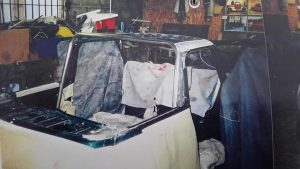The bodywork of an Auto Design Mini Cabriolet is not just a classic Mini with the roof chopped off. It has been carefully thought out to ensure that there is still structural rigidity in the body ensuring that not only are they safe, but, they don’t shake rattle and roll.
Note: These cars were designed and built using imperial measurements, and I have retained these measurements from hand written notes from Dave Champion, but, I am aware he shipped cars all over the world, and since all the nuts and bolts are imperial on these cars, I have also included what would be “foreign” to a Mini, metric measurements, in order to aid any restoration.
Centre Of Gravity Changes
You may notice if you try to jack an Auto Design Mini up using the standard cars jacking point in the sill, the rear of the car lifts, but the front of the wheel stays on the floor. This is because with the weight of the roof gone, the centre of gravity has moved forwards. In fact, a standard saloon’s centre of gravity is where the handbrake lever button is, but, on an Auto Design Mini, it is all the way forward next to your clutch (assuming right hand drive).
In removing the roof, and adding a roll bar, there is a weight saving of around 160lbs (72Kg) compared to a normal Mini, which is approximately 11%, however, performance isn’t improved due to drag.
In any “spirited” driving, it is very easy to “cock” or lift an inside rear wheel on a tight corner. This is normal and grip is not affected as the rear wheels carry little weight anyway.
Uprating rear shocks and or rubber cone springs is not required as you have insufficient weight on the rear end for it to be beneficial and would just make the ride even more bouncy. I know, I have tried.
Bodywork Differences
- Roll bar
- Roll bar rear bin strengtheners
- B post plates
- Thicker Mini outer sills
- Inner cant rail box sections
- Visor plates
Roll Bar
Every Auto Design Mini has a roll over bar made of 14 gauge 2″ (2mm thick 50mm) diameter mild steel tube bent to shape, not only curved at the B post positions, but there is a slight bend in the mid section. This tube is welded to the top of the B posts and to the rear bin strengtheners, just forwards of the “heel board” subframe mounting panel, allowing the tube to form a box section to the rest of the car’s shell. In allowing for variances in the original shell tolerances, the roll bar tube actually locates into a short 4″ 14 gauge (100mm long 2mm thick) oversize tube that is welded to the strengthener, which this is in turn welded to the floor pan, rear bins, and inner sill.
Roll Bar Rear Bin Strengtheners
You would find it difficult to weld the roll bar directly into the sill or floor of a standard Mini. This is because they come down at a canted angle. In order to resolve this, the roll bar tube is welded to a small plate that is in turn welded to both the inner sill, floor and the lower part of the passenger bin sections.
B Post Plates
There are also long narrow 14 gauge (2mm thick) triangular plates that weld between the roll bar and the B posts. This helps to tie the roll bar tube to the B posts. Then the fluted padding trim covers the whole assembly. This fluted padding is particular to all Auto Design Minis, however, a few early ones from the very early 80’s didn’t have this smart “signature” feature.
Thicker Mini Outer Sills
All Auto Design Minis have thicker outer sills made of 16 gauge (1.6mm) mild steel compared to the standard thickness. When replacing sills, you need to get some special ones made up or pressed to this higher specification in order to retain the same rigidity as the normal saloon. This is important..!
Inner Cant Rail Box Sections
The inner cant rail is the rail on the inside of the Mini that your interior light is fixed to. On an Auto Design Mini, these are welded at the top part to what is left of the roof’s last 4″ (100mm) of roof section. This helps to form yet another box section, this time above the doors, making the shell very strong.
Visor Plates
There are three 14 gauge (2mm thick) plates that are welded between the top of the windscreen and just inside the edge lip of the 4″ (100mm) roof section, two are welded behind the pull down sun visors, and one above the rear view mirror. This creates a box section running across the top of the car above the windscreen, again adding stiffness to the shell.
Structural Conclusions
As you can see from all the changes above, the cars were well thought out, and modified to a very high standard, creating a Mini cabriolet in my opinion that is structurally better than any of the competitors. I can say this as the front seat occupants are sat in a box section on thicker sills, with a roll over bar. Many competitors did not have these safety features. It also helps rigidity, reducing and shakes and rattles because it is actually still a saloon.
Cabriolet: To be? Or not to be?
However, you may ask, is it a cabriolet? Well structurally, no, because most of the saloon’s structure is still present, they are actually still a saloon car. Only the C posts and centre parts of the roof have been removed, and to compensate for a side impact, a roll bar added to return B post to B post regidity across the missing roof in a side impact accident.
Should they be re-registered as a cabriolet? No, because there has been no body type change. In fact, many rally saloon cars have a roll bar, but do not have a type change. So, what would you have to do to make it into a true cabriolet? Well, for starters, the factory during the Rover years did their own cabriolet, building on the work by the German company Lamm. However, they completely redesigned the shell and sill sections, under the rear seats, and had a different arrangement to strengthen the car underneath allowing the full roof to be removed and nothing above the waistline.
This Rover/Lamm shell is completely different to a saloon or an Auto Design Shell, requiring a different type approval for registration in many terratories, and because of this, not available in the US (see below).
Targa Top
Well, what about a targa or T-Top cabriolet? Again, no, there is no “T” structure to the roll bar, and so the sections above the doors need to still be present to remain structurally integral, and so still a sallon. An example of a targa would be the Triumph Stag or a Pontiac Trans Am Firebird, both from the mid 1970’s.
Modified Saloon
So, why did Auto Design go the modified saloon route and not a full cabriolet route like Rover/Lamm? The answer to this lies in the US market. In order to get type approval to sell a car in the US, it needed to still have the same structural regidity and stength as the saloon. If it can be demonstrated that it is still the same shell, still a saloon, and only modified, no further type approval was required, and more evidence that structurally, an Auto Deisgn Cabriolet is actually a modified saloon.
Modified Saloon Insurance
However, the insurance company need to be aware of the modifications Auto Design did at their factory in order to cover (and exclude contents) insurance.


